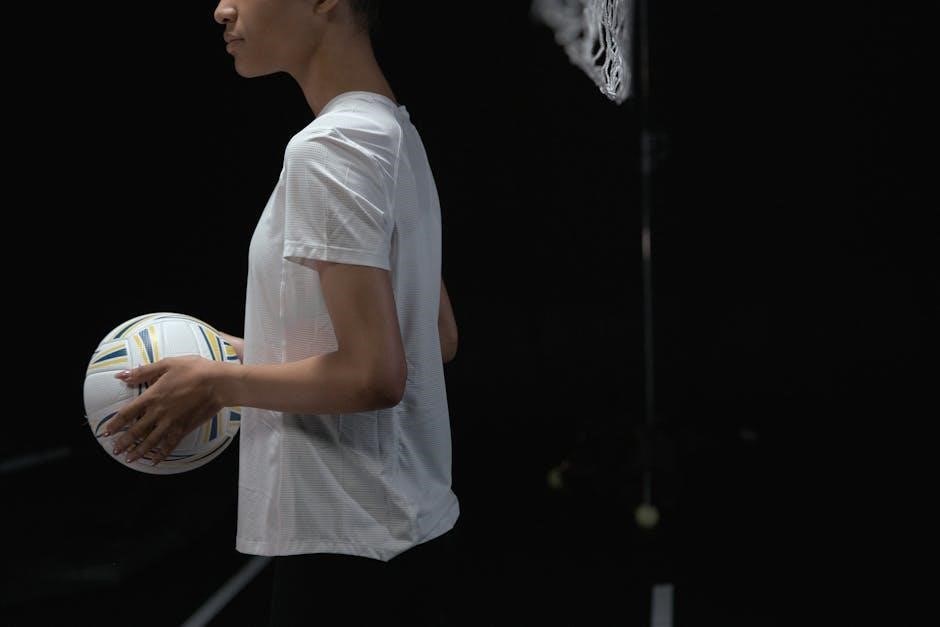Volleyball terminology forms the foundation of understanding the sport, covering essential concepts like positions, moves, and rules. It ensures clear communication among players and officials, enhancing teamwork and strategy.
1.1 Understanding the Basics of Volleyball Terms
Mastering basic volleyball terms is crucial for players and fans alike. Terms like serve, spike, and block describe fundamental actions, while set and dig highlight specific skills. Understanding these basics enhances communication and strategy on the court. Official guides and PDF resources provide comprehensive lists of terminology, ensuring clarity and consistency. These resources are invaluable for beginners and experienced players seeking to refine their knowledge. By learning these essential terms, one can better appreciate the game’s dynamics and improve their overall performance.
1.2 Importance of Terminology in Volleyball
Understanding volleyball terminology is crucial for effective communication among players, coaches, and referees. It ensures clarity in strategy execution and rule application, fostering teamwork and fair play. Clear terms help players grasp techniques, tactics, and positions, enhancing performance. Additionally, standardized terminology aids in creating resources like glossaries and training guides, making learning accessible. It also bridges language barriers, uniting the global volleyball community. Accurate terminology promotes consistency in training and competition, allowing athletes to focus on skill development. Ultimately, it enriches the sport’s complexity and ensures everyone involved shares a common language.

Types of Volleyball
Volleyball is played in various forms, including indoor, beach, and other specialized versions, each with unique rules and court dimensions, catering to different environments and player preferences.
2.1 Indoor Volleyball Terminology
Indoor volleyball terminology focuses on specific terms used in court play, such as ace, assist, block, dig, and kill. These terms describe key actions and strategies, ensuring clarity for players and officials. Understanding indoor-specific language, like set and spike, is crucial for effective communication. Terms like libero and middle blocker highlight unique roles. Indoor volleyball also includes rules like rotation and substitution, which are essential for gameplay. Mastery of this terminology enhances teamwork and tactical execution, making it vital for players at all levels to grasp these indoor volleyball terms.
2.2 Beach Volleyball Terminology
Beach volleyball terminology includes specific terms like “ace,” “assist,” and “block,” which are essential for understanding the game. An ace is a serve that lands directly on the opponent’s court without being touched. An assist occurs when a player helps another score a point. A block is when a player stops the ball at the net. These terms are crucial for strategies and communication in beach volleyball, emphasizing teamwork and skill. Understanding these terms enhances gameplay and appreciation for the sport’s unique aspects on the sand.
2.3 Other Forms of Volleyball
Beyond indoor and beach volleyball, there are several other forms, each with unique rules and terminology. Sitting volleyball, designed for players with physical disabilities, uses lower nets and emphasizes adaptability. Blind volleyball focuses on auditory cues, enhancing inclusivity for visually impaired athletes. Snow volleyball, played on snow-covered courts, combines winter sports elements with traditional gameplay. These variations expand volleyball’s global appeal, offering diverse experiences while maintaining core terminology related to scoring and gameplay. Each form has its own terminology, ensuring clarity and consistency across different formats.
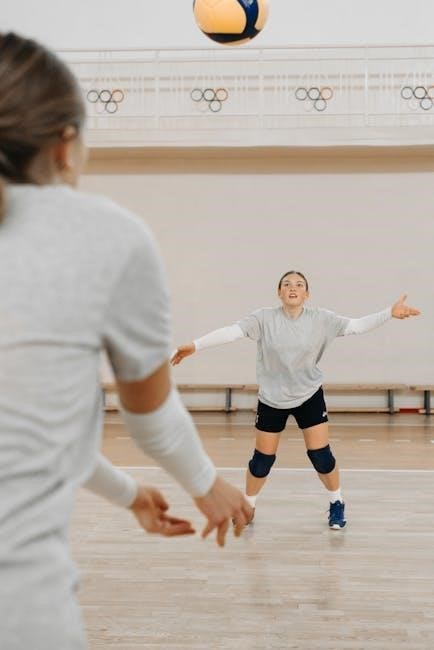
Player Positions and Roles
Volleyball teams consist of specialized positions: Setter (S), Outside Hitters (OH), Middle Blockers (MB), Opposite Hitters (OPP), and Libero (L), each with unique responsibilities and skills.
3.1 Setter (S)
The setter (S) is a pivotal position in volleyball, responsible for setting the ball to attackers. They require exceptional ball control, vision, and decision-making skills. The setter orchestrates the offense, ensuring precise timing and placement of sets. Their primary duties include receiving the serve, coordinating plays, and executing strategic decisions. A skilled setter must read the opposing team’s defense and adapt accordingly. Effective setting is crucial for creating scoring opportunities, making the setter a key playmaker in the team’s success. Their ability to communicate and lead enhances overall team performance and cohesion during matches.
3.2 Outside Hitters (OH)
Outside hitters (OH) are primary attackers and play a crucial role in scoring points. They are typically the team’s main offensive weapons, using techniques like spikes and rolls. Known for their powerful attacks, OHs often play on the left side of the court. They must excel in hitting, passing, and defense, making them versatile players. Their ability to perform under pressure and adapt to game situations is vital. Outside hitters are key to both terminating plays and creating scoring opportunities, making them indispensable in high-level competition.
3.3 Middle Blockers (MB)
Middle blockers (MB) are pivotal in both defense and attack, primarily responsible for blocking opponents’ attacks at the net. Their height and jumping ability allow them to dominate the front row. They often coordinate with setters for quick plays and are crucial in defensive strategies. Effective middle blockers read the game well, anticipating opponents’ moves to time blocks perfectly. Their role demands strength, agility, and precise timing, making them key contributors to a team’s success in both indoor and beach volleyball. Their ability to adapt and communicate enhances overall team performance, making them indispensable in high-pressure situations.
3.4 Opposite Hitters (OPP)
The Opposite Hitters (OPP) are key players in volleyball, primarily responsible for attacking and scoring points. They often serve as the team’s secondary setters and are positioned opposite the setter. Their versatility allows them to play multiple roles, including blocking and defensive actions. OPPs are typically strong hitters with the ability to adapt to various game situations. Effective communication and coordination with other players, especially the setter, are crucial for their success. The OPP’s ability to read the game and execute precise plays makes them indispensable in both indoor and beach volleyball settings.
3.5 Libero (L)
The Libero (L) is a specialized defensive player in volleyball, introduced to encourage longer rallies. They wear distinct uniforms and are restricted to playing in the back row; The Libero excels in digging, passing, and reading opponents’ plays. They cannot attack, block, or set balls. Their role is critical for defensive strategies and maintaining team organization. The Libero’s ability to anticipate and react quickly is vital for the team’s success. They are also key communicators, directing teammates during plays. This position emphasizes defensive expertise and tactical awareness, making the Libero a cornerstone of modern volleyball tactics. Their impact is felt through consistent, reliable performance.
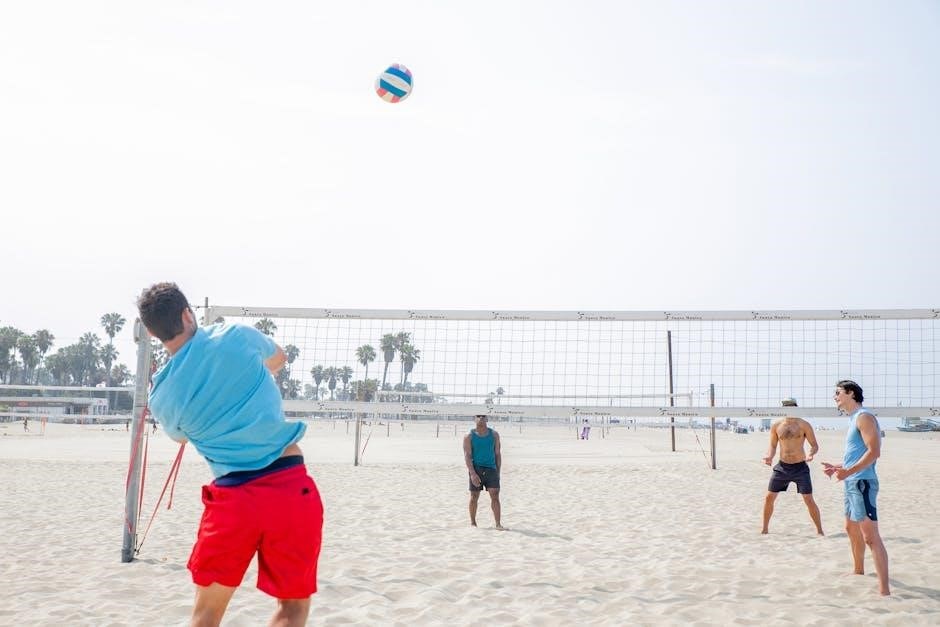
Scoring and Game Elements
Scoring elements in volleyball include aces, assists, blocks, digs, and kills, each contributing to a team’s points and game strategy execution.
4.1 Ace
An ace in volleyball is a serve that results in an immediate point for the serving team. It occurs when the ball is served in such a way that it lands directly on the opponent’s court without being touched by any player. A well-executed ace can disrupt the opponent’s rhythm and boost the serving team’s momentum.
Aces are often achieved through precise placement, power, or deception. They are a key element in a team’s offensive strategy and demonstrate a player’s serving skill. Accurate serves that exploit weaknesses in the opponent’s reception can lead to a higher ace count, making them a valuable asset in competitive play.
4.2 Assist
An assist in volleyball is awarded when a player helps a teammate score a point, typically by setting the ball perfectly for an attack. This action is crucial in team strategy, as it directly contributes to scoring opportunities. The setter usually earns the most assists, but any player can contribute. Assists highlight teamwork and coordination, making them a key statistic in evaluating player performance. They are officially recorded and showcase a player’s ability to create scoring chances, emphasizing the importance of collaboration in achieving success on the court.
4.3 Block
A block in volleyball occurs when a player stops the ball at the net, preventing it from crossing over to their side. It is a defensive action that can be executed individually or in coordination with teammates. A successfully executed block results in the opposing team losing the rally and the blocking team earning a point. Blocks are crucial for disrupting the opponent’s offensive plays and gaining momentum in the game. Proper timing, positioning, and teamwork are essential for effective blocking, making it a key skill in volleyball strategy.
4.4 Dig
A dig is a defensive action in volleyball where a player prevents the ball from hitting the ground using their forearms or hands. It is a crucial skill that allows the team to maintain possession of the ball and continue the rally. Players often dive or stretch to reach the ball, showcasing their agility and reflexes. A successful dig not only motivates the team but also demonstrates strong defensive capabilities. While it doesn’t directly score a point, a well-executed dig significantly impacts the game’s momentum and transitions the ball to the setter for offensive plays.
4.5 Kill
A kill in volleyball is a successful attack that results in an immediate point, typically when the ball cannot be returned by the opposing team. It is a key offensive statistic, highlighting a player’s ability to score. Kills often occur when a hitter strikes the ball sharply, making it impossible for defenders to react. This action is crucial in high-pressure situations, showcasing both power and precision. Accurate spikes and well-timed approaches are essential for executing effective kills, making them a cornerstone of a team’s offensive strategy.
Volleyball Rules and Faults
Understanding volleyball rules and faults is essential for fair play. Key faults include carries, lifts, and double contacts, each impacting gameplay and scoring opportunities significantly.
5.1 Let
A “Let” in volleyball refers to a call made by the referee when the ball touches the net but continues over to the opponent’s side, allowing play to continue. It is not considered a fault and does not result in a point or side-out. The ball remains in play, and the opposing team has the opportunity to continue the rally. A “Let” is often confused with a fault but is distinct, as it does not stop play. Proper understanding of this term is crucial for players and officials to manage game flow effectively and maintain fair play.
5.2 Carry
A “carry” in volleyball refers to a fault where the ball is illegally held or carried by a player, rather than being cleanly hit. This occurs when the ball comes to rest or is gripped, often resulting in a point for the opposing team. Carries are distinct from other faults like lifting or double contact, as they involve prolonged control of the ball. Proper hand positioning and quick, precise movements are essential to avoid carries. Officials closely monitor player-ball contact to enforce this rule, ensuring fair play and maintaining the game’s integrity. Carries are a key aspect of understanding volleyball terminology and rules.
5.3 Lifting
Lifting in volleyball refers to a fault where a player uses an overhead motion to hold or carry the ball, rather than making contact with the forearms. This action is illegal and results in a point for the opposing team. Lifting often occurs during defensive plays or when attempting to set the ball. Proper technique, such as using forearms for passes, is essential to avoid this violation. Officials closely monitor player movements to ensure fair play and enforce rules consistently. Understanding lifting helps players refine their skills and maintain legal gameplay.
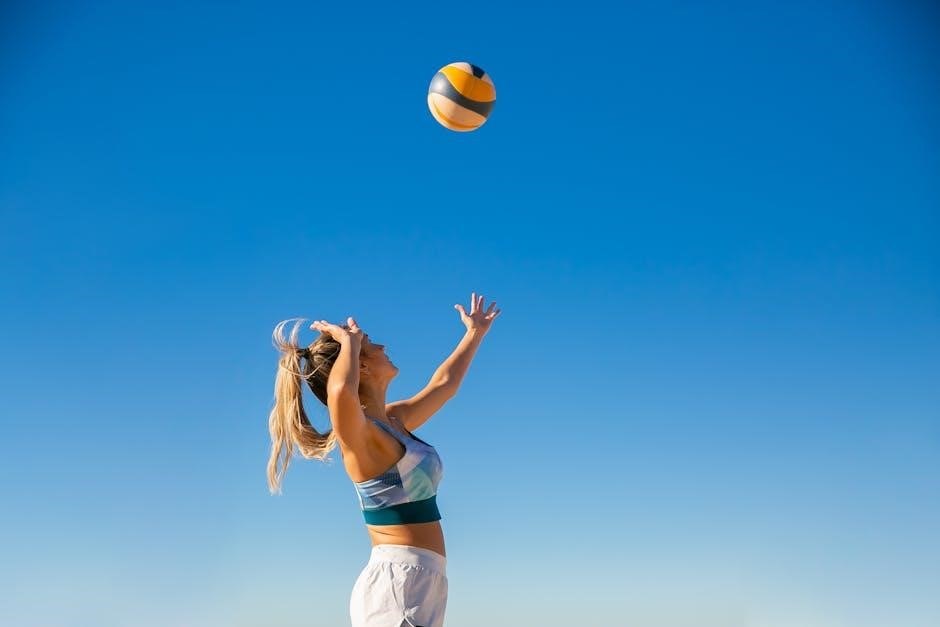
5.4 Double Contact
A double contact occurs when a player touches the ball twice consecutively without another player interfering. This is considered a fault, penalizing the offending team. It often happens during passes or sets, where a player may unintentionally hold or lift the ball. Double contact is strictly enforced to maintain fair play and prevent advantage. For example, if a player uses their arms to pass and then immediately touches the ball again, it is ruled a double contact. This rule applies to all players, emphasizing the importance of clean, precise movements in volleyball technique.
5.5 Net Interference
Net interference in volleyball occurs when a player touches the net or interferes with the ball while it is over the net. This is considered a fault, resulting in a point for the opposing team. Accidental contact with the net is also penalized if it affects gameplay. Players are expected to avoid any physical contact with the net during play. Intentional interference, such as reaching over the net to block or attack, is strictly prohibited. Understanding and adhering to this rule ensures fair play and maintains the integrity of the game. Proper training and awareness are key to avoiding such penalties.
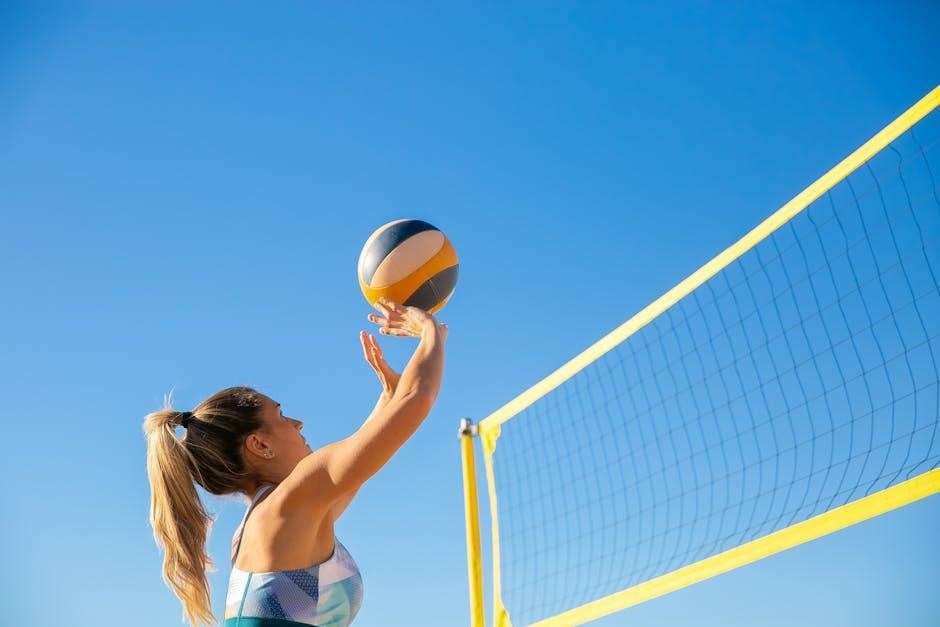
Advanced Techniques
Advanced techniques in volleyball include spike, slide, roll shot, and overhead pass, enhancing offensive and defensive strategies with power, precision, and teamwork.
6.1 Spike
A spike in volleyball is an offensive play where a player attacks the ball to hit it over the net into the opponent’s court. It involves a powerful downward swing, aiming to make the ball land on the opponent’s side. Players typically approach the net, jump high, and strike the ball sharply with their wrists and arms. Timing and precision are crucial for an effective spike. The spike is a key element in scoring and is often the result of a well-executed set. It requires strength, technique, and teamwork to perform successfully, making it a fundamental skill in advanced volleyball strategies.
6.2 Slide
The slide is an advanced volleyball technique used by hitters to quickly approach the net. It involves a specific footwork pattern, allowing players to create a sharp angle for hitting. Executed by starting in a ready stance, the slide begins with a small step forward, followed by a lateral movement and a jump. This technique enhances offensive versatility, making it harder for defenders to anticipate the attack. Proper timing and coordination with the setter are crucial. The slide is widely used in both indoor and beach volleyball to add variety to offensive plays and increase scoring opportunities.
6.3 Roll Shot
The roll shot is an advanced offensive technique in volleyball, designed to deceive opponents. It involves hitting the ball with an open hand, using a soft, rolling motion to direct it over the net. Unlike a spike, the roll shot relies on precision rather than power, making it harder for defenders to anticipate. Players typically use this shot to exploit gaps in the defense or when the block is too strong. Proper timing and wrist control are crucial for executing an effective roll shot. It’s often used by experienced players to add variety to their attacking strategies and maintain offensive unpredictability.
6.4 Overhead Pass
The overhead pass, a fundamental skill in volleyball, involves using the hands to contact the ball above the head. It is commonly used in indoor volleyball to set the ball for an attack. The arms are raised overhead, elbows slightly bent, and the ball is directed toward the intended target. Proper technique requires precise timing and hand positioning to ensure accuracy; Unlike underhand passes, the overhead pass relies on arm strength and coordination. It is crucial for setters and players to master this skill for effective gameplay, as it directly impacts the team’s offensive strategy and overall performance on the court.
Common Volleyball Injuries
Common injuries include back strains and hand injuries from diving and blocking. Proper training, equipment, and warm-ups can reduce these risks effectively.
7.1 Shoulder Injuries

Shoulder injuries are common in volleyball due to repetitive overhead movements like spiking and blocking. Rotator cuff strains, dislocations, and impingements are frequent issues. These injuries often result from overuse or poor technique. Players may experience pain, limited mobility, and weakness. Prevention includes proper warm-ups, strength training, and technique correction. Recovery involves rest, ice, and physical therapy. Addressing shoulder injuries promptly is crucial to avoid long-term damage and maintain performance. Understanding these risks is essential for athletes to adopt protective measures and ensure longevity in the sport.
7.2 Knee Injuries
Knee injuries are common in volleyball due to repetitive jumping, landing, and quick directional changes. They often involve ligament sprains, meniscus tears, or patellar tendinitis. Proper warm-ups, strengthening exercises, and technique adjustments can help prevent these issues. Players should focus on balanced muscle development and avoid overtraining to reduce the risk of knee-related problems. Immediate medical attention is crucial for severe injuries to prevent long-term damage. Understanding these risks and taking preventive measures is essential for maintaining player health and performance in volleyball.
7.3 Ankle Sprains
Ankle sprains are common injuries in volleyball, often caused by quick direction changes or landings from jumps. They occur when ligaments surrounding the ankle stretch or tear. Symptoms include pain, swelling, and limited mobility. Prevention involves strengthening exercises, proper footwear, and warming up. Treatment typically follows the RICE method (Rest, Ice, Compression, Elevation). Severe cases may require physical therapy or bracing. Understanding ankle sprains is crucial for players to maintain performance and reduce recurrence, emphasizing the importance of injury prevention in volleyball training and gameplay.
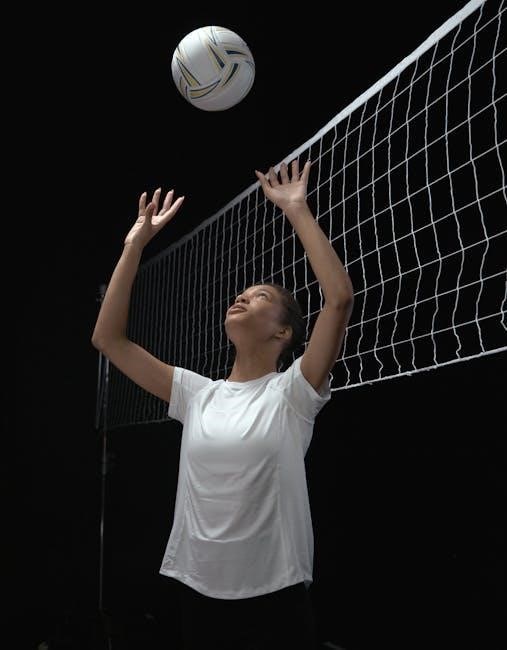
Training and Practice
Effective training involves drills, skill development, and strategic practice. It enhances teamwork, strength, and agility, ensuring players master techniques like spiking and blocking for optimal performance.
8.1 Drills for Beginners
Beginner drills focus on mastering basic volleyball skills like passing, setting, and hitting. Forearm passing drills involve stationary and moving exercises to improve control. Overhead passing drills teach proper hand positioning and timing. Serving drills, such as underhand and overhand serves, help build consistency. Spiking drills start with simple approaches and progress to more dynamic movements. These drills are essential for building a strong foundation and ensuring players understand game fundamentals before advancing to complex strategies.
8.2 Advanced Training Techniques
Advanced training in volleyball involves specialized drills and strategies to enhance player skills. Techniques like slide attacks, roll shots, and advanced blocking methods are emphasized. Players refine their overhead passes and spikes through precise footwork and arm swing exercises. Strength conditioning, including plyometrics and core workouts, is integral to improving power and agility. Video analysis is used to review performance, allowing for targeted improvements. These methods help players master complex plays and adapt to high-level competition, ensuring they are prepared for the demands of professional volleyball.
- Slide attacks and roll shots
- Advanced blocking and defensive strategies
- Strength and plyometric training
- Video analysis for performance review
8.3 Warm-Up Exercises
A proper warm-up is essential for volleyball players to prepare their muscles and prevent injuries. Dynamic stretching, such as arm circles and leg swings, improves flexibility and range of motion. Light cardio exercises like jogging or jumping jacks increase heart rate and blood flow. Volleyball-specific drills, such as passing and serving, help players focus and refine their skills. Incorporating these exercises ensures players are physically and mentally ready for practice or competition. A well-structured warm-up enhances performance and reduces the risk of injury, making it a crucial part of every training session.
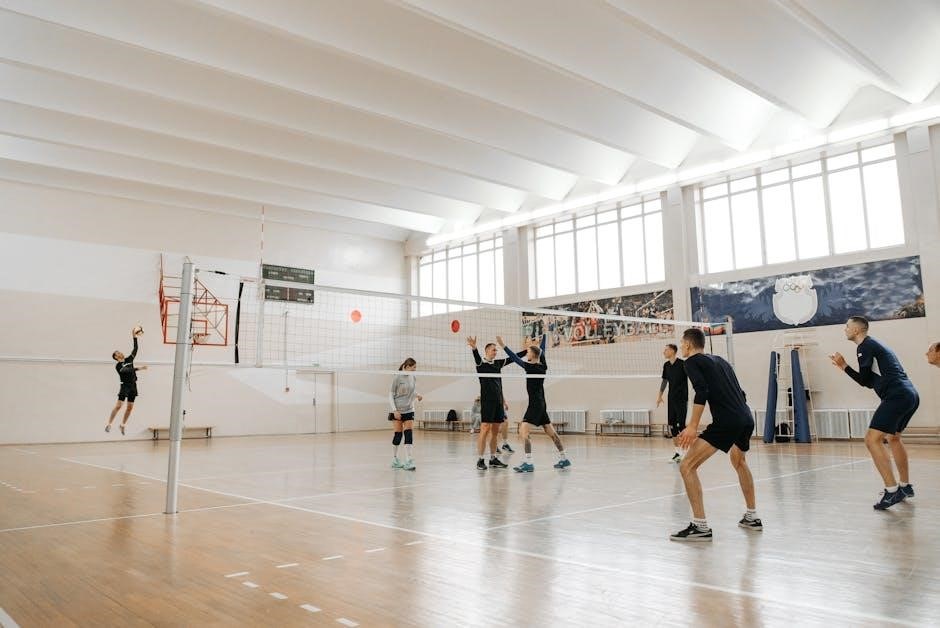
Volleyball Terminology Resources

Explore comprehensive resources like PDF guides, glossaries, and online platforms for mastering volleyball terminology. These tools provide detailed explanations and visual aids to enhance understanding and accessibility.
9.1 Glossaries of Terms
Glossaries of volleyball terms provide comprehensive lists of definitions essential for understanding the sport. These resources cover basic to advanced terminology, ensuring clarity for players, coaches, and fans. Key terms include Ace (a serve scoring a point), Assist (setting the ball for a kill), and Block (stopping the ball at the net). They also explain specialized terms like Dig (defensive save) and Kill (successful attack). Glossaries are vital for mastering volleyball jargon, making them indispensable tools for anyone involved in the game. They are widely available in PDF formats for easy access and reference.
9.2 PDF Guides and Downloads
PDF guides are an excellent resource for mastering volleyball terminology. They provide comprehensive glossaries, diagrams, and explanations of key terms. Many official volleyball federations and educational platforms offer downloadable PDF manuals. These resources often include drills, strategies, and rulebooks. For instance, the Manual on Terminology by НН Бобырева and F Miftari’s studies are widely referenced. These guides are perfect for coaches, players, and enthusiasts seeking in-depth knowledge. They cover everything from basic terms to advanced techniques, ensuring a thorough understanding of the sport.
Downloading PDF guides allows offline access, making them ideal for training sessions or quick references. They are structured to cater to all skill levels, from beginners to professionals. Whether you’re learning the fundamentals or refining your expertise, these resources are invaluable. Explore official volleyball websites or educational platforms to find reliable PDF guides tailored to your needs.
9.3 Online Learning Platforms
Online learning platforms offer extensive resources for mastering volleyball terminology. Websites like Coursera, Udemy, and specialized sports education portals provide courses and tutorials. Mobile apps such as Volleyball Terms and Sports Dictionary offer quick access to definitions. YouTube channels dedicated to volleyball coaching share video explanations. Additionally, platforms like Khan Academy and TED-Ed include sports-related content. These resources often include downloadable PDF guides, interactive drills, and quizzes. They cater to both beginners and advanced players, ensuring comprehensive understanding of volleyball terminology. These platforms are invaluable for anyone looking to deepen their knowledge of the sport’s language and strategies.
